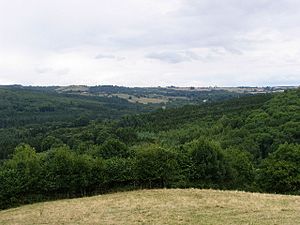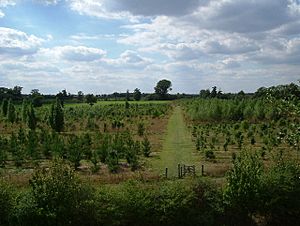Woodland Trust facts for kids
 |
|
| Formation | 1972 |
|---|---|
| Legal status | Non-profit company and registered charity |
| Purpose | Woodland conservation |
| Location |
|
|
Region served
|
UK |
|
Membership
|
300,000 |
|
Chief Executive
|
Darren Moorcroft |
|
Main organ
|
Board of Trustees |
|
Budget
|
£82.5 million |
The Woodland Trust is the biggest charity in the United Kingdom that works to protect woodlands. Its main goals are to create new woods, protect existing ones, and bring back native woodlands. Since 1972, the Trust has planted over 68 million trees.
The Woodland Trust has three key aims:
- To protect ancient woodlands, which are very special and cannot be replaced.
- To help damaged ancient woodlands grow back strong and healthy.
- To plant new native trees and woods for the benefit of both people and wildlife.
The charity owns and looks after more than 1,000 sites. These cover over 33,000 hectares (about 127 square miles). A large part of this land, 8,070 hectares, is ancient woodland. The Woodland Trust makes sure that people can visit and enjoy its woods.
Contents
History of the Woodland Trust
The Woodland Trust was started in 1972 by Kenneth Watkins. He was a retired farmer from Devon, England.
The Trust's very first purchase was a part of the Avon Valley Woods in Devon. By 1977, it owned 22 woods in six different counties. In 1978, the charity moved its main office to Grantham in Lincolnshire. It then announced plans to expand its work across the whole UK. In 1984, Balmacaan Wood, next to Loch Ness, became the first wood the Trust bought in Scotland.
From 2005 to 2008, the charity worked with the BBC on their Springwatch TV show. They also helped with the BBC's Breathing Places events in woods. The Trust continues to work with Springwatch and Autumnwatch. For example, in 2015, they encouraged viewers to record signs of nature. This was part of the Trust's Nature's Calendar project.
Woodland Trust Sites Across the UK
As of 2024, the Woodland Trust manages over 60 woods in Scotland. These woods cover a large area of 11,000 hectares.
In Wales, the Trust bought Coed Lletywalter in Snowdonia National Park in 1980. This wood is 94 acres (about 38 hectares). By 2024, the Trust had over 100 woods in Wales. These woods cover almost 3,000 hectares.
Work began in Northern Ireland in 1996. The charity received money to create over 50 community woods. This project was called "Woods on Your Doorstep."
Where the Woodland Trust is Based
The first employee and director of the Trust was John James. He was chief executive from 1992 to 1997. After him, Michael Townsend, Sue Holden, and Beccy Speight held the role. The current chief executive is Darren Moorcroft.
A new, environmentally friendly headquarters was finished in 2010. It cost £5.1 million to build. The building was designed to use natural daylight and concrete panels. These features help keep the building warm in winter and cool in summer. The timber structure also saved a lot of carbon compared to a concrete building.
How the Woodland Trust is Organized
The main office of the Woodland Trust is in Grantham, Lincolnshire. There are also smaller offices in other parts of the UK. About 300 people work at the Grantham headquarters.
Clive Anderson has been the president of the Trust since 2003. In 2016, Barbara Young, Baroness Young of Old Scone became the charity's chair.
How the Woodland Trust Gets Money
The Woodland Trust gets money from many different places. This includes money from its members, gifts left in wills, and donations. Companies also support the Trust. It receives grants and money from other charities, including lottery funding.
What the Woodland Trust Does
The Woodland Trust uses its knowledge to help others improve the future of native woodlands. This includes working with the government and other landowners. It also runs campaigns to protect ancient woodland from being destroyed by new buildings.
The Trust has special projects for young people, like Nature Detectives. It also runs a project for schools called Nature's Calendar. This project helps students learn about how seasons affect woodlands. Another project is the Ancient Tree Hunt campaign.
Protecting Woodlands
The Trust looks after more than 1,000 woods and groups of woods. These cover about 190 square kilometers (73 square miles). Nearly 350 of these sites contain ancient woodland. This means the land has been covered by trees since at least the year 1600. The Trust also manages over 110 Sites of Special Scientific Interest. These are special places for wildlife. Currently, over 600 ancient woods in the UK are at risk.
Creating New Woodlands
The Trust has also created many new woodlands. Over 32 square kilometers (12 square miles) of new woods have been planted. This includes 250 new community woods in England, Wales, and Northern Ireland.
Some of its biggest projects include the Glen Finglas Estate in the Trossachs, Scotland. This area covers 41.7 square kilometers. Another large project is the Heartwood Forest near St Albans, Hertfordshire, England. This forest will cover about 347 hectares. The Trust also owns 20 sites in the National Forest. It has twelve sites in Community Forests in England.
The Woodland Trust also gives free trees to communities and schools. This helps more new woodlands to be created.
Completed Projects
Millennium Woods
The Woodland Trust's "Woods on Your Doorstep" project created 250 "Millennium woods." These woods were planted to celebrate the year 2000.
Trafalgar Woods
As part of the Trust's "Tree For All" campaign, new woods were planted. This was to mark the 2005 anniversary of the Battle of Trafalgar. One notable wood is Victory Wood in Kent.
Jubilee Woods
The Trust ran the Jubilee Woods project. The goal was to plant 6 million trees. They also aimed to create 60 special "Diamond" woods across the UK. This was part of Elizabeth II's Diamond Jubilee celebrations in 2012. The largest of these is the Flagship Diamond Wood in the National Forest. It was planted with 300,000 trees.
First World War Centenary Woods
Starting in 2014, a project honored the First World War. It involved planting trees and creating new woodlands across the UK. The main sites were Langley Vale Wood (England), Dreghorn Woods (Scotland), Coed Ffos Las (Wales), and Brackfield Wood (Northern Ireland).
As part of this project, the Woodland Trust worked with the National Football Museum. They created "team groves" to remember all the professional football players who were in the First World War. Supporters could dedicate trees at Langley Vale in Epsom.
Ongoing Initiatives
Nature's Calendar
This is a "citizen science" project. It asks people to record signs of the seasons where they live. This helps to show how climate change is affecting UK wildlife. Thousands of volunteers send in their observations. This provides important information about how wildlife is reacting to the changing climate.
The Trust's records for this project go back to 1736. This makes it the longest written record of its kind. It is a very useful tool for scientists studying climate change.
Ancient Tree Inventory
The Ancient Tree Inventory is a project run by the Woodland Trust. It works with the The Tree Register and the Ancient Tree Forum. The goal is to record ancient, veteran, and important trees in the United Kingdom. As of 2022, over 180,000 trees have been recorded by people on the project's website. The website also shows a map of these trees.
Woods Owned by the Trust

Here are some of the woods the Woodland Trust owns and looks after:
England
- Denge Wood, Kent
- Dick Buck's Burrows, Cromer, Norfolk
- Five Ponds Copse, Cheshire
- Folke Wood, Dorset
- Friezland Wood, Kent
- Furzehill Wood, Dorset
- Garratts Wood, Somerset
- Great Wood, Felbrigg Estate, Norfolk
- Hack Fall Wood, North Yorkshire
- Heartwood Forest, Hertfordshire
- Joyden's Wood, Kent
- Lineover Wood SSSI, Gloucestershire
- Oldmoor Wood, Nottinghamshire
- Oxmoor Copse, Surrey
- Philipshill Wood, Buckinghamshire
- Pretty Corner Wood, Sheringham, Norfolk
- Skipton Wood, North Yorkshire
- Tarn Wadling, Cumbria
- Uffmoor Wood, Worcestershire
- Warren Wood, Norfolk
- Whittaker Wood, Greater Manchester
- Whittlewood Forest, Northamptonshire
- Weybourne Wood, Weybourne, Norfolk
- West Runton, West Runton, Norfolk
- Wychwood, Oxfordshire
Scotland
- Backmuir Wood, Angus
- Glen Finglas Estate, the Trossachs
Wales
- Coed Felinrhyd & Llennyrch
- Coed Ffos Las
Northern Ireland
- Brackfield Wood
- Monkstown Wood
See also




